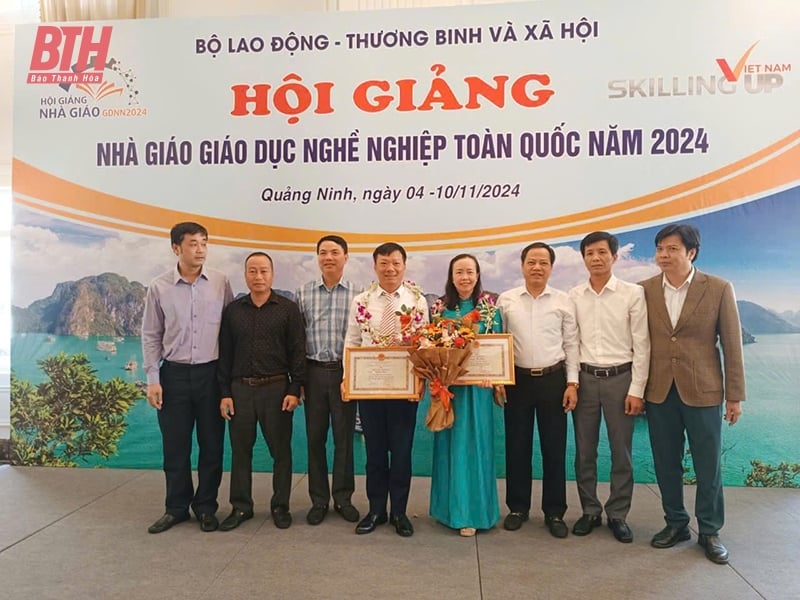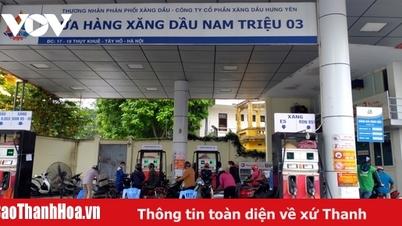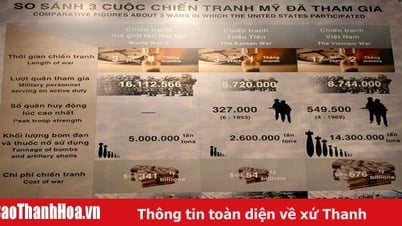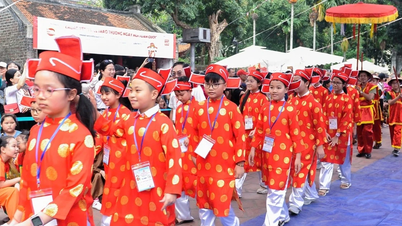2 teachers from Thanh Hoa Industrial College won prizes at the 2024 National Vocational Education Teachers' Conference.
Currently, there are 5 universities in the province that are training and developing human resources. On average, each year, universities provide the labor market with about 3,600 human resources. In addition, there are about 2,500 students from Thanh Hoa who graduated from universities outside the province and returned to work in the locality.
Along with the development of higher education, 66 vocational training institutions in the province have implemented solutions to improve the quality of human resource training. The schools clearly identify the strong professions and key economic sectors of the province to focus on building them into high-quality training faculties and majors that meet national and regional standards. At the same time, they develop and promulgate output standards for each training major and profession in accordance with social requirements.
In the period of 2021-2024, vocational training institutions and enterprises in the province have recruited, trained, and mentored about 334,576 people. Of which, 16,004 people have college degrees; 46,074 people have intermediate degrees; 389,367 people have primary and training courses under 3 months. The average employment rate after graduation is 90%, with some occupations such as welding, fashion sewing, and industrial electricity having employment rates of 100%. That has contributed to the gradual increase in the province's trained labor rate over the years. If in 2021 the province's trained labor rate was 71%, by 2024 it had increased to 74%.
Along with training and human resource development, the activities of job fairs organized periodically at the Thanh Hoa Employment Service Center and mobile job fairs in localities have contributed to connecting labor supply and demand. Moreover, the construction of harmonious labor relations in enterprises has received special attention. Currently, with 22,000 operating enterprises, jobs have been created for over 440,000 people. Of which, state-owned enterprises have created jobs for about 13,658 people; private enterprises have created jobs for 217,622 people; FDI enterprises have created jobs for about 184,020 people. In addition, there are 2,004 foreigners working in the province.
Although some results have been achieved, awareness of training and human resource development in some localities is still inadequate and some training occupations have not met the requirements of the labor market. On the other hand, there is a shortage of skilled labor, highly qualified labor, skilled labor and leading experts, especially in key economic sectors. More importantly, many people have not been proactive and actively studying to equip themselves with a profession to be ready to participate in the labor market. Meanwhile, enterprises in the province are mainly small and micro enterprises (accounting for over 97%), with weak competitiveness and inefficient operations, so the ability to attract labor is not high. Many students and graduates have not found jobs or have to work in fields other than their training, causing waste of resources. Along with that, the quality of jobs of companies and enterprises in the province is not high and the stability and sustainability of jobs are still low.
To improve the efficiency of human resource development and use, especially high-quality human resources with vocational skills to meet the socio-economic development requirements of the province and to supply domestic provinces and cities as well as foreign markets, universities and vocational training institutions in the province need to innovate and improve the quality of education and training. The focus is on promoting digital transformation in education, modernizing facilities and teaching equipment. At the same time, focusing on developing and improving the quality of vocational education, especially innovating vocational training for rural workers to meet the requirements of industrialization and modernization of agriculture and rural areas. The quality and effectiveness of vocational education must ensure a reasonable scale, structure, level, and training professions, linked to output standards, in the direction of openness, connectivity, modernity, integration and adaptation to the needs of the labor market. In addition, the province continues to promote socialization, mobilizing maximum resources for investment in vocational education development. Prioritizing the development of vocational education institutions with developing occupations, meeting the demand for human resources in key economic sectors. Encouraging enterprises to participate in vocational education activities and establish private schools and schools with foreign investment capital. Improving the capacity of the human resource forecasting system and labor market information, associated with promoting job creation. In particular, the province needs to implement strategic breakthroughs in human resource development and preferential policies to promote and attract high-quality human resources, in order to promote rapid and sustainable socio-economic development, commensurate with the potential and strengths of the province.
Article and photos: Mai Phuong
Source: https://baothanhhoa.vn/su-dung-nguon-nhan-luc-dap-ung-yeu-cau-phat-tien-kinh-te-xa-hoi-245543.htm



![[Photo] Cultural, sports and media bloc at the 50th Anniversary of Southern Liberation and National Reunification Day](https://vphoto.vietnam.vn/thumb/1200x675/vietnam/resource/IMAGE/2025/4/30/8a22f876e8d24890be2ae3d88c9b201c)
![[Photo] The parade took to the streets, walking among the arms of tens of thousands of people.](https://vphoto.vietnam.vn/thumb/1200x675/vietnam/resource/IMAGE/2025/4/30/180ec64521094c87bdb5a983ff1a30a4)



![[Photo] Chinese, Lao, and Cambodian troops participate in the parade to celebrate the 50th anniversary of the Liberation of the South and National Reunification Day](https://vphoto.vietnam.vn/thumb/1200x675/vietnam/resource/IMAGE/2025/4/30/30d2204b414549cfb5dc784544a72dee)
















![[Photo] Performance of the Air Force Squadron at the 50th Anniversary of the Liberation of the South and National Reunification Day](https://vphoto.vietnam.vn/thumb/1200x675/vietnam/resource/IMAGE/2025/4/30/cb781ed625fc4774bb82982d31bead1e)



































































Comment (0)